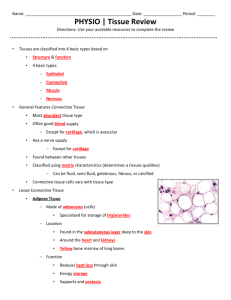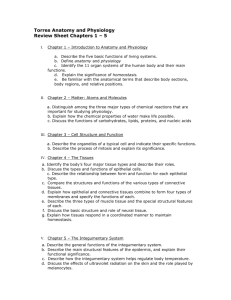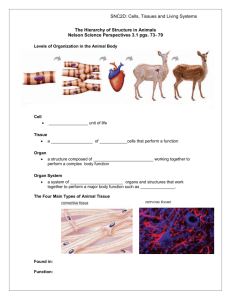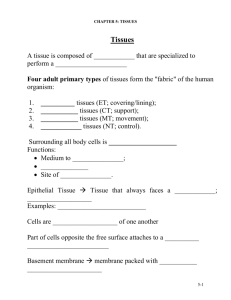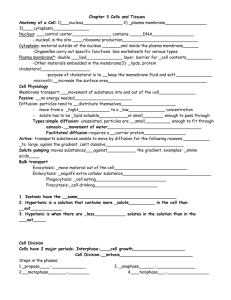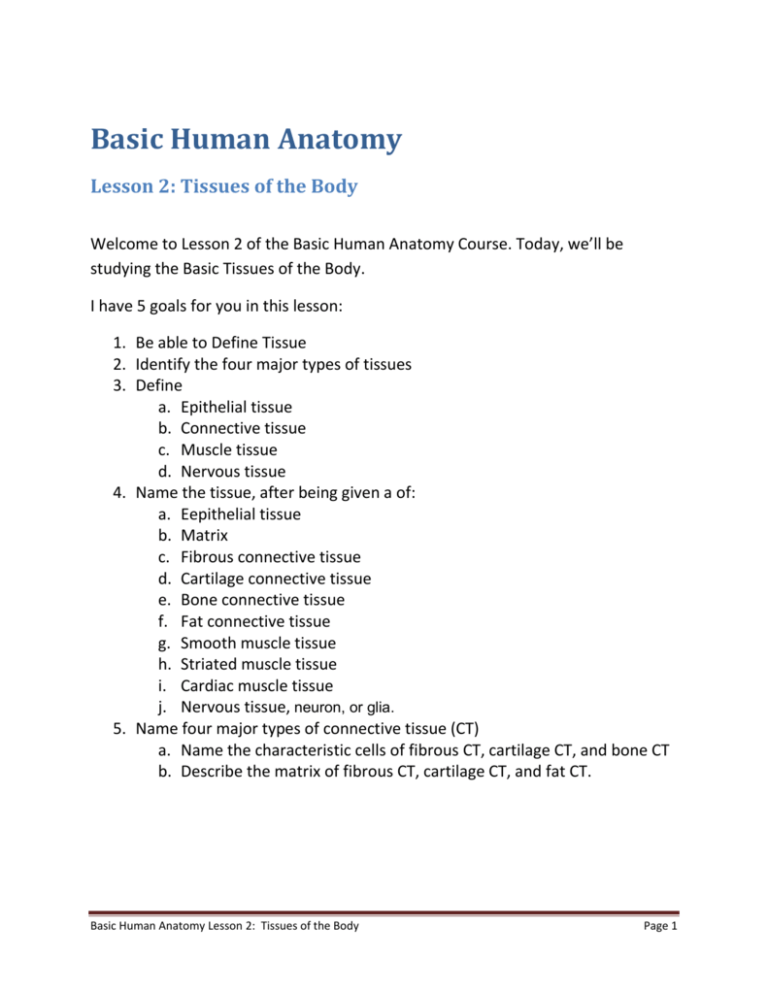
Basic Human Anatomy
Lesson 2: Tissues of the Body
Welcome to Lesson 2 of the Basic Human Anatomy Course. Today, we’ll be
studying the Basic Tissues of the Body.
I have 5 goals for you in this lesson:
1. Be able to Define Tissue
2. Identify the four major types of tissues
3. Define
a. Epithelial tissue
b. Connective tissue
c. Muscle tissue
d. Nervous tissue
4. Name the tissue, after being given a of:
a. Eepithelial tissue
b. Matrix
c. Fibrous connective tissue
d. Cartilage connective tissue
e. Bone connective tissue
f. Fat connective tissue
g. Smooth muscle tissue
h. Striated muscle tissue
i. Cardiac muscle tissue
j. Nervous tissue, neuron, or glia.
5. Name four major types of connective tissue (CT)
a. Name the characteristic cells of fibrous CT, cartilage CT, and bone CT
b. Describe the matrix of fibrous CT, cartilage CT, and fat CT.
Basic Human Anatomy Lesson 2: Tissues of the Body
Page 1
DEFINITION
A tissue is a grouping of like cells working together.
TYPES OF TISSUES
There are several major types of tissues. The most common types are epithelial,
connective, muscle, and nervous tissues. Later, this lesson will discuss each type.
TISSUES AND ORGANS
a. Tissues make up organs. An organ is a structure performing a particular
function. An organ is composed of several different tissues. Examples of organs
are the lungs and the heart.
b. In some cases, a term may be used to describe both a type of tissue and a kind
of organ. For example, we speak of bone tissue and of bones. We speak of muscle
tissue and of muscles.
DEFINITION OF EPITHELIAL TISSUES
Epithelial tissue is tissue that covers surfaces and lines cavities. Here, it may
protect, absorb, and/or secrete. Epithelial tissue covers the outer surface of the
body. It lines the intestines, the lungs, and other hollow organs.
Basic Human Anatomy Lesson 2: Tissues of the Body
Page 2
TYPES OF EPITHELIAL CELLS (BY SHAPE)
Figure 2-1 illustrates the basic types of epithelial cells by shape. The three basic
shapes are squamous (flat), cuboidal (cubes), and columnar (columns).
Figure 2-1. Epithelial cells.
TYPES OF EPITHELIAL TISSUES
a. Layers. In epithelial tissues, the cells are in single or multiple layers. If there
is only one layer, the tissue is called a simple epithelium. If there is more
than one layer, the tissue is called a stratified epithelium. See figure 2-2.
Figure 2-2. Types of epithelial tissues.
Basic Human Anatomy Lesson 2: Tissues of the Body
Page 3
b. Naming. Epithelial tissues are named by the number of layers and the type of
cell in its outermost layer. For example, if there are several layers and if the
outermost layer consists of squamous (flat) cells, then the tissue is called a
stratified squamous epithelium.
c. Examples of Epithelial Tissues.
(1) A simple squamous epithelium called endothelium lines the heart and blood
vessels.
(2) As serous membranes, simple squamous epithelial tissue lines the cavities of
the abdomen (peritoneal lining) and the chest (pleural lining). Serous membranes
are membranes which secrete a lubricating fluid.
(3) Epithelial tissue forms the secretory part of glands and also parts of the
various sense organs.
d. Functions. According to its location, epithelial tissue has different functions. As
the skin, epithelial tissue protects the tissues beneath. In the small intestines, the
epithelial tissue absorbs. In the lungs, epithelial tissue is a membrane through
which the gases pass easily. In the glands, epithelial tissue secretes.
DEFINITION OF CONNECTIVE TISSUES
a. Connective tissue is tissue that supports other tissues, holds tissues together,
or fills spaces.
b. Among and outside the cells of the connective tissues, there is a material called
matrix. The matrix is manufactured by the connective tissue cells. Each type of
connective tissue has its own particular type of matrix.
Basic Human Anatomy Lesson 2: Tissues of the Body
Page 4
TYPES OF CONNECTIVE TISSUE
There are several major types of connective tissue (CT). These include fibrous CT
(FCT), cartilage CT, bone CT, and fat CT. Blood is sometimes considered an
additional type of CT.
FIBROUS CONNECTIVE TISSUE (FCT)
a. Fibroblasts. The characteristic cells of FCT are fibroblasts. Fibroblasts are able
to form elongated fibers.
b. Matrix. These fibers make up the matrix of FCT.
c. Fibers. The fibers are either white or yellow.
(1) White fibers are made from a protein called collagen. White fibers tend to
have a fixed length. White fibers are not very easily stretched.
(2) Yellow fibers are made from a protein called elastin. Yellow fibers are elastic.
They can be stretched and then they can snap back (like a rubber band).
d. Types of FCT. The types of FCT are recognized by the arrangement of their
fibers. These types include:
(1) Loose areolar FCT. Loose areolar FCT has an open irregular arrangement of its
fibers.
AREOLAR = airy
Basic Human Anatomy Lesson 2: Tissues of the Body
Page 5
Loose areolar FCT is found widely throughout the body. An example is the
superficial fascia (subcutaneous layer). The superficial fascia is the connective
tissue which lies beneath the skin. Loose areolar FCT is the filling substance
around most organs and tissues of the body.
(2) Dense FCT. The fibers of dense FCT are closely packed and parallel. There are
no significant spaces between the fibers. Examples of dense FCT are ligaments
and tendons. A ligament is a band of dense FCT that holds the bones together at a
joint. A tendon attaches a muscle to a bone.
CARTILAGE CONNECTIVE TISSUE
a. Cartilage Cells. Cartilage cells are also called chondroblasts. Cartilage cells are
clustered in microscopic pockets within the cartilage matrix. The cartilage cells
produce the material of the matrix.
b. Matrix. The matrix produced by the cartilage cells appears homogeneous (the
same throughout). The matrix also appears amorphous (shapeless).
c. Types of Cartilage CT.
(1) Hyaline cartilage CT. Hyaline cartilage CT appears homogeneous and clear.
HYALINE = clear
This type of cartilage helps to cover bone surfaces at joints. Hyaline cartilage is
found as incomplete rings which keep the trachea (windpipe) open.
(2) Fibrous cartilage CT. Fibrous cartilage CT includes dense masses of fibers (of
FCT). It is more rigid than hyaline cartilage. The auricle of the external ear is
stiffened with fibrous cartilage.
Basic Human Anatomy Lesson 2: Tissues of the Body
Page 6
(3) Calcified cartilage CT. Calcified cartilage CT is cartilage that has been stiffened
by the addition of calcium salts. This is not the same as bone tissue. An
example is the cartilages of the larynx (the voice box) which become calcified with
age.
BONE CONNECTIVE TISSUE
a. Osteoblasts/Osteoclasts. Osteoblasts are cells that make and repair bone.
Osteoclasts are cells which tear down and remove bone. Bone is continually being
remodeled as a person lives. Remodeling is in direct response to the stresses
placed on the bone.
b. Types of Bone Tissues. There are two major types of bone tissue. One is
compact bone CT, which is dense. The other is cancellous bone CT, which is
spongy. Compact bone CT forms the hard outer layers of bones as organs.
Cancellous bone CT forms the inner, lighter portion of bones.
FAT CONNECTIVE TISSUE
a. Fat Cells. A large fraction of the volume of a fat cell is occupied by a droplet of
fat. This droplet has its own membrane, in addition to the outer membrane of the
cell. The remaining components of the fat cell, including the nucleus, are found in
an outer layer of cytoplasm surrounding the droplet of fat.
b. Matrix. Fat connective tissue has a matrix of lipid (oil or fat). There may be
yellow fat CT or brown fat CT.
c. Functions. Fat CT acts as a packing material among the organs, nerves, and
vessels. Fat CT also helps to insulate the body from both heat and cold. Some fat
CT serves as a high-energy storage area.
Basic Human Anatomy Lesson 2: Tissues of the Body
Page 7
BLOOD "CONNECTIVE TISSUE"
Some experts consider blood to be a type of connective tissue. Blood will be
discussed in lesson 9.
DEFINITION OF MUSCLE TISSUES
There are muscle tissues and there are organs called muscles. Muscles are made
up of muscle tissues. Muscle tissues and the muscles they make up are specialized
to contract. Because of their ability to shorten (contract), muscles are able to
produce motion.
TYPES OF MUSCLE TISSUES
See figure 2-3 for the three types of muscle tissue.
a. Skeletal Muscle Tissue. The cells (muscle fibers) of skeletal muscle tissue are
long and cylindrical and have numerous nuclei. The arrangement of the cellular
contents is very specific and results in a striated appearance when viewed with
the microscope. This type of muscle tissue is found mainly in the skeletal muscles.
Figure 2-3. Types of muscle tissue.
Basic Human Anatomy Lesson 2: Tissues of the Body
Page 8
b. Cardiac Muscle Tissue. The cells (muscle fibers) of cardiac muscle tissue are
short, branched, contain one nucleus, and are striated. This tissue makes up the
myocardium (wall) of the heart.
c. Smooth Muscle Tissue. The cells (muscle fibers) of smooth muscle tissue are
spindle-shaped, contain one nucleus, and are not striated. Smooth muscle tissue
is generally found in the walls of hollow organs such as the organs of the digestive
and respiratory systems, the blood vessels, the ureters, urinary bladder, urethra,
and reproductive ducts.
DEFINITION OF NERVOUS TISSUE
Nervous tissue is a collection of cells that respond to stimuli and transmit
information.
NERVOUS TISSUE CELLS
a. A neuron (figure 2-4), or nerve cell, is the cell of the nervous tissue that actually
picks up and transmits a signal from one part of the body to another. A synapse
(figure 2-5) is the point at which a signal passes from one neuron to the next.
b. The neuroglia (also known as glia) is made up of the supporting cells of the
nervous system (glial cells).
c. The nervous tissues will be discussed in a later lesson.
Basic Human Anatomy Lesson 2: Tissues of the Body
Page 9
Figure 2-4. A neuron.
Basic Human Anatomy Lesson 2: Tissues of the Body
Page 10
Figure 2-5. A synapse.
Introduction to Basic Human Anatomy is a distance learning product that is based on the
Correspondence Subcourse MD0006 of the U.S. Army Medical Department Center and School.
This presentation was produced by the Brookside Associates, Ltd., which is privately-held and
not connected to any governmental agency. The views expressed here are those of the authors,
and unless otherwise noted, do not necessarily reflect the views of the Brookside Associates,
Ltd., any governmental agencies or private organizations. This presentation is unclassified, and
© 2009, with all rights reserved.
Basic Human Anatomy Lesson 2: Tissues of the Body
Page 11



